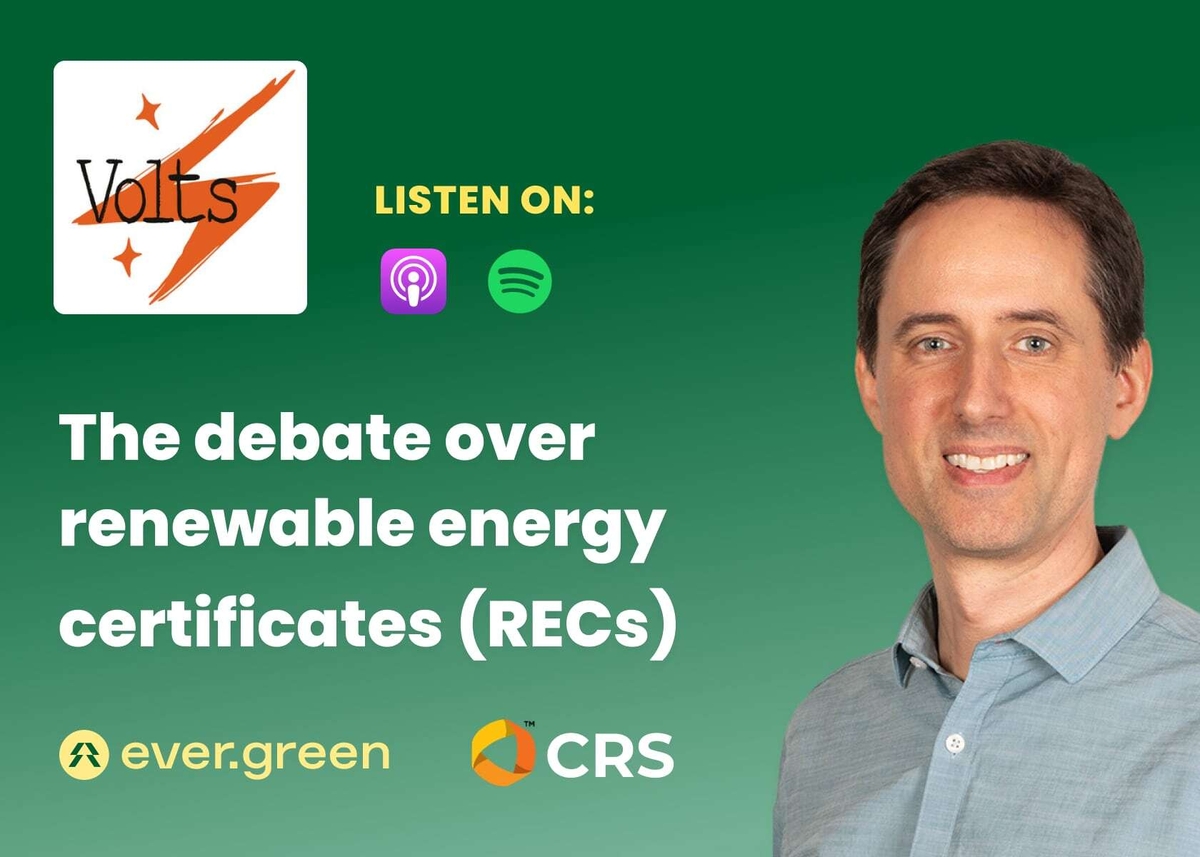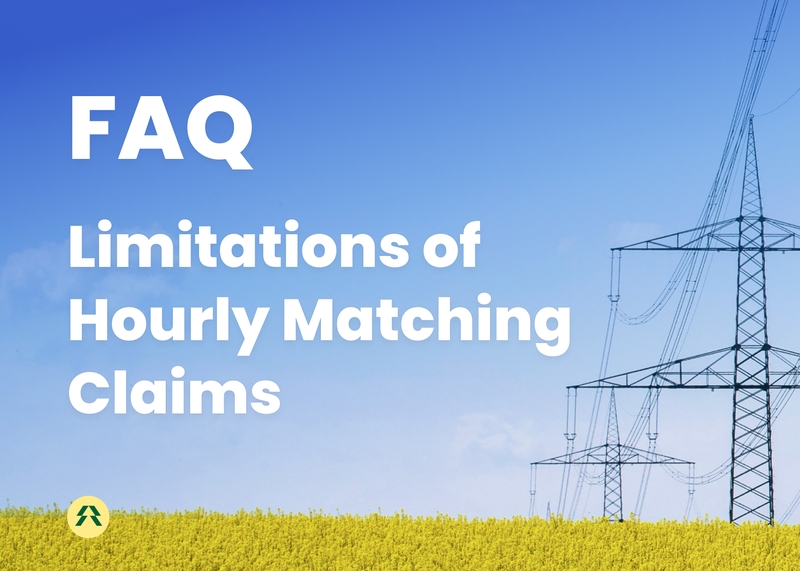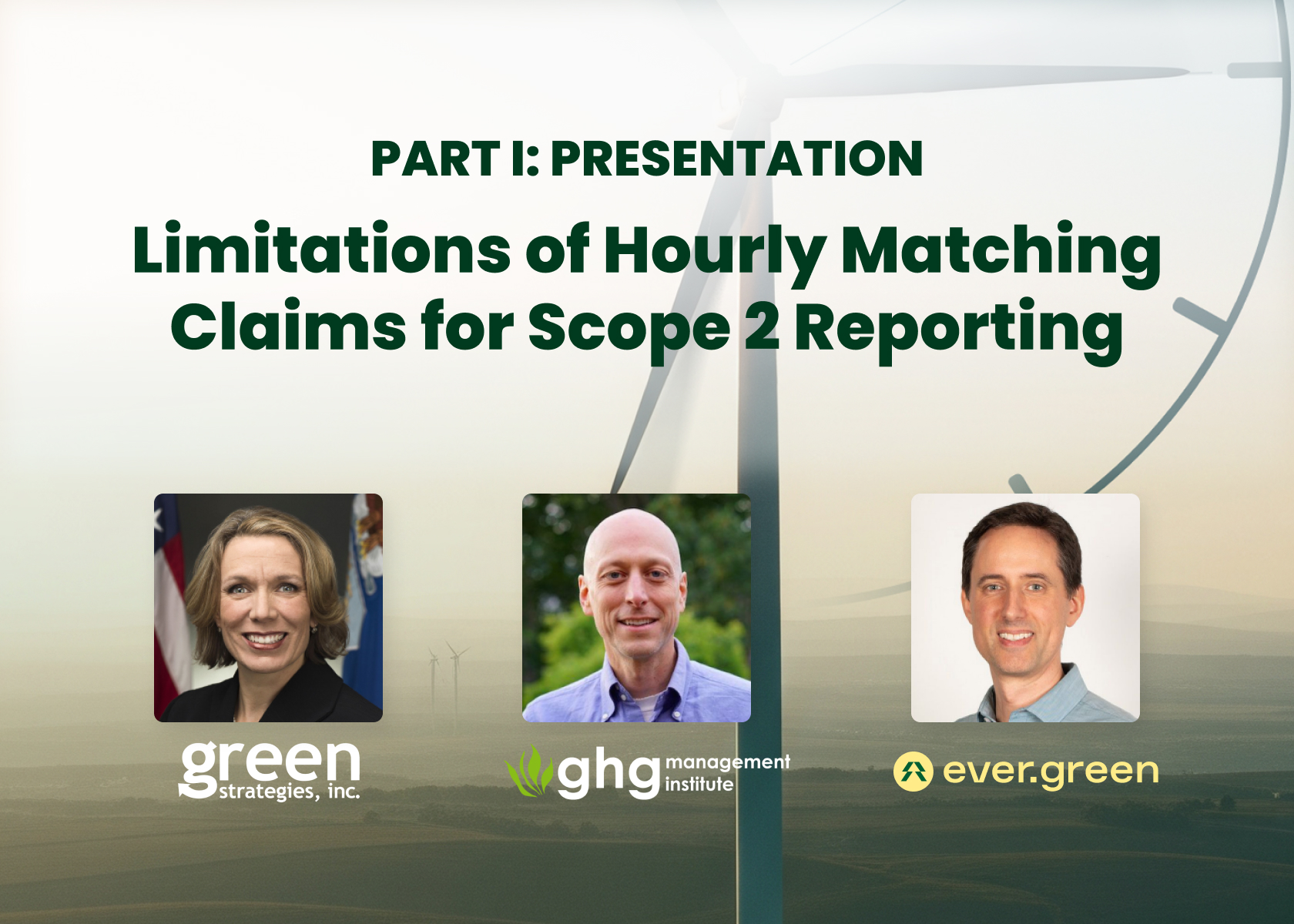Webinar Q&A: Limitations of Hourly Matching for Scope 2 Reporting
Webinar Q&A on Limitations of Hourly Matching for Scope 2 Reporting (Part 2)
Aug 18, 2025
The greenhouse gas accounting world is facing a major shift. The Greenhouse Gas Protocol (GHG Protocol) is the global standard for corporate emissions reporting and they are revising its Scope 2 guidelines for the first time in over a decade. The proposed changes would fundamentally alter how companies account for their renewable energy purchases, potentially requiring "hourly matching" where companies can only claim emissions reductions from clean energy generated at the same time and location as their electricity consumption.
This isn't just an accounting technicality. These rules underpin major climate frameworks like the Science Based Targets initiative and influence billions of dollars in corporate clean energy procurement. The changes could reshape renewable energy markets, affect the economics of power purchase agreements (PPAs), and impact how quickly we decarbonize our world.
Following our recent webinar on the limitations of hourly matching for Scope 2 reporting, we received many thoughtful questions from attendees. Below are more detailed answers to some of the questions asked during the webinar as well as questions we did not get to regarding the proposed changes to GHG Protocol's Scope 2 standard.
Resources:
- Watch the Webinar Part 2 discussion
- Read the Webinar Pat 1 Q&A or watch the Webinar Part 1 presentation
- Download our white paper: "The Limitations of Hourly Matching for Scope 2 Reporting" (co-authored with the GHG Management Institute)
ADDITIONAL Q&A FROM PART 2:
What’s actually being proposed?
Are the GHG Protocol updates forcing buyers to do 100% hourly matching, i.e. 24/7 carbon-free energy (CFE)?
Formally, no. Functionally, yes. The update changes how Market-Based Method claims are counted so you may only use RECs that match the hour and location of usage. While GHG Protocol is not a target-setting body, it underpins frameworks like Science Based Targets initiative (SBTi), which are currently proposing to require 100% hourly/location matching. The pressure to maintain “zero” Scope 2 goals means companies will be compelled to reach for 24/7 CFE.
Can I still count RECs from my existing PPA?
GHG Protocol has recommended and the ISB has voted in favor of honoring existing long-term contracts but rules and conditions are not final. Furthermore, SBTi v2.0 draft does not currently honor existing contracts, creating a double bind for buyers. Hopefully this oversight can be corrected as we need rules that are consistent across stacking standards so buyers have greater certainty when considering signing 10-20 year forward contracts.
The theory behind hourly matching
What is the theory of change for 24/7 CFE? Why has it become the sole option for updating the Market-Based Method?
The theory of change for 24/7 CFE (carbon free energy) is that if buyers focus procurement on the hours and locations where clean supply is scarce, their demand could drive new projects and technologies to fill those gaps, helping the grid fully decarbonize. But impact still depends on whether the procurement actually enables new clean generation. 24/7 CFE risks reshuffling existing nuclear and hydro supply and reducing meaningful support for adding needed solar and wind capacity that accelerates the transition to renewable energy.
Does hourly matching fix credibility problems with current claims (e.g., using California solar power at night in Maine)?
By limiting more extreme mismatches, hourly matching can improve the perception of credibility. But because grid physics make tracing impossible, the inventory is no more verifiable than under annual matching. Claiming accuracy perpetuates a misunderstanding about how electricity is delivered based on a false concept of flowing electrons (rather than the maintenance of charge on a connected wire).
The deeper reputational risk is not credible usage claims but whether claims are tied to real decarbonization. The main credibility gap identified by press and research for years is that cheap, unbundled RECs often do little to enable new projects. Instead, they divide credit for generation that would have happened anyway.
Hourly matching does not fix that problem, and can even shift demand away from PPAs that finance new builds toward existing nuclear or hydro to meet 24/7 targets. The key question is whether purchases materially accelerate clean energy deployment. If not, the accounting method, whether hourly or annual, will not restore credibility.
Doesn't research show hourly matching is most impactful?
No. Capacity-expansion models that appear to favor hourly matching usually assume away market realities. Under assumptions like frictionless contracting, constant demand, ambitious CFE targets, no additional soft costs, and no PPA crowd-out, hourly matching can look more impactful. But that’s perception, not reality.
- Accuracy vs. credibility: Hourly matching may reduce implausible mismatches, but it does not make inventories more accurate. Electricity cannot be traced to specific loads — so hourly rules improve optics, not truth. The real credibility gap, documented in research and press, is that cheap unbundled RECs do little to add capacity. Over 800 U.S. companies are now using PPAs to close that gap. Hourly rules don’t fix this and can even weaken PPAs by shifting demand to existing nuclear or hydro.
- Granularity vs. decarbonization: More granular accounting doesn’t guarantee more impact. In the real world, rigid hourly requirements raise costs, shrink participation, and divert demand away from long-term contracts into short-term supply. What maximizes real decarbonization is the trifecta of long-term contracts standing up more new projects in locations where they will do the most to turn off power generated by fossil fuels.
Analysis by McKinsey, E3, Baringa, and others highlight these unintended consequences. We should preserve a path that incentivizes and rewards companies for taking on the work, cost, and risk of high-impact long-term contracts to enable more capacity rather than make it harder and more costly.
Could hourly matching actually increase emissions?
Yes, hourly matching can backfire if it drives companies to prioritize matching their own load over reducing system-wide emissions. Time-shifting load or discharging storage during high-marginal-emissions hours can help, but if those actions are guided solely by a matching requirement rather than marginal-emissions data, they can increase total emissions. Similarly, focusing on matching may steer procurement toward existing nuclear or hydro resources that address all hours but do nothing to add new clean generation.
Commercial and practical impacts
Do you see an hourly matching requirement pushing more companies towards unbundled RECs rather than towards PPAs?
Absolutely. We expect it will push more companies toward unbundled RECs rather than grow the use of PPAs. Here's why:
- PPAs aren't available in all regions, and virtual PPAs become unavailable when you can only use locally generated RECs.
- Costs rise sharply when one PPA must be replaced by many smaller regional deals.
- Companies risk signing PPAs but not being able to use all the RECs when they don't match hourly load patterns.
- These issues are especially problematic for companies with distributed operations, shifting locations, or mobile assets.
The easiest way to avoid these added risks is to skip long-term contracts altogether and buy what you need in spot markets.
Is the data infrastructure ready for hourly matching?
Not everywhere. While some regions have hourly metering and hourly REC registries, many don't. The proposed rules allow for estimates when hourly data isn't available, but estimates aren't sufficient for demand-side flexibility, without which, hourly matching becomes even more expensive. And by accepting estimates without penalties or time limits, the draft may actually discourage utilities and registries from ever upgrading their systems.
One can construct examples that support annual matching and that support hourly/regional matching. What are the underlying assumptions that flip the conclusion and how robust are those assumptions in practice?
Exactly — the outcome depends on the assumptions. Hourly/regional matching often looks best in models that assume frictionless contracting, constant demand, ambitious CFE targets, no additional soft costs, no impact on PPA uptake, etc. Annual matching looks bad when you focus on spot-market transactions from existing projects at low prices and much better when you focus on companies using long-term PPAs that enable new project financing (how the majority of RECs are purchased in the U.S. since 2023). Neither are perfect and the current standards need to be improved. The key is testing how sensitive the conclusions are to these assumptions, because if they do not hold in practice, the modeled “optimal” approach may not deliver in the real world.
Additionality and impact
Is the primary purpose of impact metrics (A) to support voluntary corporate impact claims or (B) to evaluate the impact of decisions around technology, siting, and operation?
When evaluating the impact of indirect corporate actions, such as buying credits from another project, we should consider both: (A) the impact of the credits on enabling additional projects, and (B) the impact of the project itself on the planet and global emissions. When a utility is building projects they are required to build, (A) is generally assumed and it makes sense to focus on (B). But for companies seeking to have an impact through external projects, it is wise to consider both.
Can’t companies use impact reporting alongside hourly matching in market-based reporting? Is there really a problem?
The proposal to allow separate reporting on consequential impact and emissions impact was supported by the TWG (GHGP Technical Working Group) but voted down by the ISB (GHGP Independent Standards Board) and will not be included in the public comments. So for now, it is hourly+local matching or bust.
A separate working group (AMI) is being asked to consider consequential impact outside of the Scope 2 revisions but it was dissolved earlier this year. If resurrected, the Scope 2 working group is so far ahead of all the working groups it seems unlikely anything will be ready when the Scope 2 rules change.
Will the new rules require companies to prove their projects are "additional"?
Not likely. The track that would have considered additionality was voted down by the ISB. What remains is a proposal that only tests for hourly and locational matching for better optics around usage claims, not tests of whether procurement enables new clean energy. Without an explicit pathway for consequential impact, corporations could meet the new rules with existing resources that do nothing to expand clean generation. If the goal is real emissions impact, additionality should be built into the framework. Otherwise the credibility gap that prompted this update will remain.
Why didn't the GHGP ISB back the Technical Working Group’s recommendations to advance consequential impact?
We cannot speak for the ISB’s internal reasoning, but the vote suggests concerns about complexity, timing, and/or alignment with the current Scope 2 revision process. Advancing impact accounting alongside hourly matching would have opened a parallel path focused on actual emissions impact and additionality, which many in the TWG saw as essential. By not moving it forward, the ISB has effectively put all emphasis on hourly matching which increases the risk that we improve the precision of claims without improving real-world decarbonization. It is possible this work will continue under a separate working group but there is great risk and uncertainty in the timeline of that work being completed on the same timeline as the scope 2 revisions.
Are all new projects guaranteed to be additional from an emissions perspective? If not, how much added cost will there be to corporate customers to have their projects verified?
No, not all new projects are additional. Some are required by policy, sufficiently supported by other subsidies, or would be built anyway due to market conditions. Verifying additionality adds cost, but can be scaled depending on the test. Legal attestations are low-cost and can be effective. Financial tests require more data but are still modest relative to overall PPA transaction costs. The key is designing a test that is credible, consistent, and affordable, so buyers can have confidence their procurement is driving real emissions reductions without pricing them out of the market.
How can we operationalize additionality? We've heard GHG Protocol sees a long-term corporate PPA as insufficient without further evidence.
From a project finance perspective, a 10+ year offtake that is signed pre-funding, covers a meaningful share of revenue, and is priced to support debt sizing is exactly what enables many projects to get built. It is one of the clearest causal links between a corporate action and new clean generation. Rather than endless debates about what would have happened otherwise, we could define clear criteria for high-impact contracts and verify deals meet them.
Is the marginal impact method considered offsetting?
No, The marginal impact method measures how much a procurement changes total system emissions compared to what would have happened otherwise. It focuses on causation and grid-wide impact, not on one-for-one balancing of emissions. It's attribution of influence on the system, not a trade in emission reductions.
The path forward
How can companies influence this process?
GHG Protocol plans to publish draft revisions in October with a public comment period following. This will be the best opportunity for companies to understand how proposed changes could affect their operations and the broader clean energy market—and to make their voices heard.
What do you see as the right solution?
The goal should be improving both accuracy and impact with broad enough participation that there is large impact. We need accounting methods that reward procurement demonstrably adding new more clean energy to the grid AND ways to incentivize the projects and technologies that make clean energy available every hour.
The better path allows hourly matching as an option to improve accuracy while preserving accessible pathways for high-impact long-term contracts backed by clear impact criteria. Accuracy without impact risks reshaping markets around accounting exercises that leave actual emissions largely unchanged.
GHG Management Institute is coming out with several new papers soon proposing a new multi-statement reporting framework that addresses these issues with market based approaches. Stay tuned to the GHG Management Institute newsletter.
Ever.green drafted our own proposal for scope 2 but fundamentally, we care most about having options that allow and incentivize long-term contracts like PPAs rather than make them harder.
For more analysis on these topics, see our research at ever.green/insights or contact us at sales@ever.green. The draft GHG Protocol revisions are expected in October 2025, with public comments to follow. Companies should prepare to engage in this process to ensure the final rules support both credible accounting and meaningful decarbonization.






